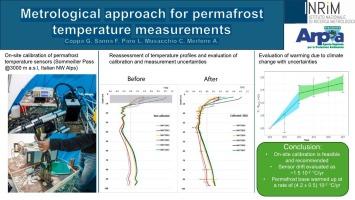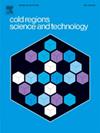Metrological approach for permafrost temperature measurements
IF 3.8
2区 工程技术
Q1 ENGINEERING, CIVIL
引用次数: 0
Abstract
Permafrost degradation is a growing direct impact of climate change. Detecting permafrost shrinkage, in terms of extension, depth reduction and active layer shift is fundamental to capture the magnitude of trends and address actions and warnings. Temperature profiles in permafrost allow direct understanding of the status of the frozen ground layer and its evolution in time. The Sommeiller Pass permafrost monitoring station, at about 3000 m of elevation, is the key site of the regional network installed in 2009 during the European Project “PermaNET” in the Piedmont Alps (NW Italy). The station consists of three vertical boreholes with different characteristics, equipped with a total of 36 thermistors distributed in three different chains. The collected raw data shows a degradation of the permafrost base at approximately 60 m of depth since 2014, corresponding to about 0.03 °C/yr. In order to verify and better quantify this potential degradation, three on-site sensor calibration campaigns were carried out to understand the reliability of these measurements. By repeating calibrations in different years, two key results have been achieved: the profiles have been corrected for errors and the re-calibration allowed to distinguish the effective change of permafrost temperatures during the years, from possible drifts of the sensors, which can be of the same order of magnitude of the investigated thermal change. The warming of permafrost base at a depth of ∼ 60 m has been confirmed, with a rate of (4.2 ± 0.5)∙10−2 °C/yr. This paper reports the implementation and installation of the on-site metrology laboratory, the dedicated calibration procedure adopted, the calibration results and the resulting adjusted data, profiles and their evolution with time. It is intended as a further contribution to the ongoing studies and definition of best practices, to improve data traceability and comparability, as prescribed by the World Meteorological Organization Global Cryosphere Watch programme.

冻土温度测量的计量方法
永冻土退化是气候变化带来的日益严重的直接影响。从延伸、深度减少和活动层转移等方面检测永久冻土的收缩,对于把握趋势的严重程度以及采取行动和发出警告至关重要。通过永久冻土的温度曲线,可以直接了解冻土层的状况及其随时间的演变。Sommeiller Pass 永久冻土监测站海拔约 3000 米,是 2009 年欧洲 "PermaNET "项目在皮埃蒙特阿尔卑斯山(意大利西北部)建立的区域网络的主要站点。该站由三个不同特性的垂直钻孔组成,共配备 36 个热敏电阻,分布在三个不同的链条上。收集到的原始数据显示,自 2014 年以来,约 60 米深的永久冻土层基底出现退化,相当于每年约 0.03 °C。为了验证并更好地量化这种潜在的退化,进行了三次现场传感器校准活动,以了解这些测量的可靠性。通过在不同年份重复校准,取得了两项重要成果:校正了剖面误差,重新校准可区分多年来永久冻土温度的有效变化与传感器可能发生的漂移,后者可能与调查的热变化量级相同。深度为 60 米的冻土层基底变暖已得到证实,变暖速度为 (4.2 ± 0.5)∙10-2 °C/年。本文报告了现场计量实验室的实施和安装情况、采用的专用校准程序、校准结果和由此产生的调整数据、剖面及其随时间的变化情况。本文旨在为正在进行的最佳做法研究和定义做出进一步贡献,以便按照世界气象组织全球冰冻圈观察计划的规定,提高数据的可追溯性和可比性。
本文章由计算机程序翻译,如有差异,请以英文原文为准。
求助全文
约1分钟内获得全文
求助全文
来源期刊

Cold Regions Science and Technology
工程技术-地球科学综合
CiteScore
7.40
自引率
12.20%
发文量
209
审稿时长
4.9 months
期刊介绍:
Cold Regions Science and Technology is an international journal dealing with the science and technical problems of cold environments in both the polar regions and more temperate locations. It includes fundamental aspects of cryospheric sciences which have applications for cold regions problems as well as engineering topics which relate to the cryosphere.
Emphasis is given to applied science with broad coverage of the physical and mechanical aspects of ice (including glaciers and sea ice), snow and snow avalanches, ice-water systems, ice-bonded soils and permafrost.
Relevant aspects of Earth science, materials science, offshore and river ice engineering are also of primary interest. These include icing of ships and structures as well as trafficability in cold environments. Technological advances for cold regions in research, development, and engineering practice are relevant to the journal. Theoretical papers must include a detailed discussion of the potential application of the theory to address cold regions problems. The journal serves a wide range of specialists, providing a medium for interdisciplinary communication and a convenient source of reference.
 求助内容:
求助内容: 应助结果提醒方式:
应助结果提醒方式:


